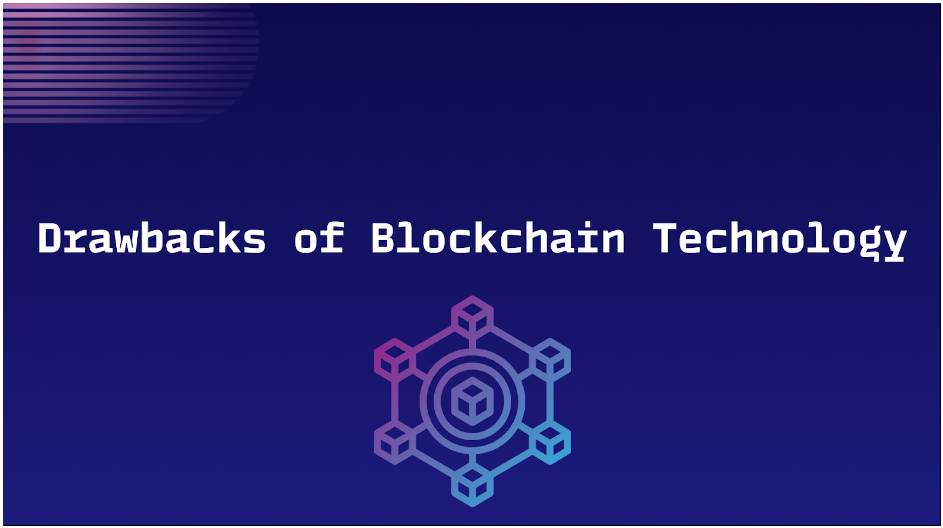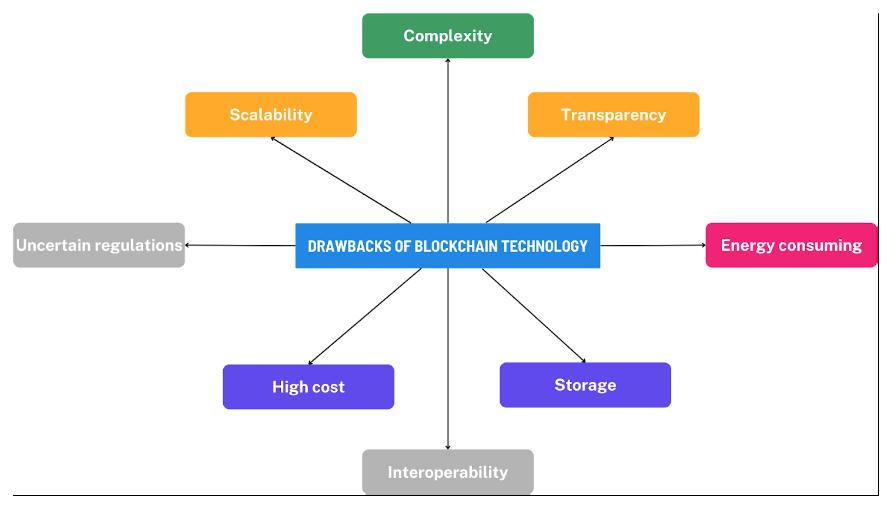Drawbacks of Blockchain Technology

With its revolutionary potential for secure data storage and sharing, blockchain technology has captured the attention of people all over the globe.But, blockchains need more storage space and are inefficient compared to traditional centralised databases. Blockchain technology has gone a long way from its infancy, but there are still a number of problems that require fixing before it can be used for regular transactions by many.
Come with me if you want to know more about Blockchain drawbacks. Here’s a quick look at some of its drawbacks:

- Complexity
A major disadvantage of blockchain technology is its complexity. Because of their complexity, these systems need expert knowledge of network protocols, consensus techniques, and cryptography.This complexity challenges developers in creating and maintaining blockchain applications. Moreover, it raises the risk of errors and vulnerabilities more likely, which might lead to security breaches and financial losses. Also, companies could be afraid to invest in systems with a high level of complexity since they are difficult to comprehend and put into practice.
- Scalability
Due to its scalability challenge, blockchain finds it difficult to process several transactions at once. The network may get congested as more transactions are added, leading to delays and increased costs. This is a big problem for applications that need to process lots of transactions fast, like payment systems or decentralised apps. Developers are working on fixes for this, such as sharding, which divides the network into smaller sections so that more transactions can be handled, and off-chain transactions. Blockchain’s scalability remains a significant barrier in spite of these initiatives.
- Transparency
Blockchain functions similarly to a public digital ledger in that it records all transactions. There are privacy issues, but there are also trust-building benefits to this transparency. For example, on Bitcoin and other public blockchains, every transaction is seen by everybody. For those who value privacy in their financial dealings, this may not be the best option. On the other hand, there are situations when transparency is advantageous, such as in supply chain management, where it helps in product tracking and fraud prevention. While blockchain’s immutability is undoubtedly a positive, it may pose challenges where user privacy is paramount.
- High Energy Consumption
A substantial amount of computer power is required to solve difficult mathematical riddles in order to complete mining, which is the process of confirming transactions on a blockchain. Because of this energy usage, particularly in blockchains that are based on proof-of-work (PoW), such as Bitcoin and Ethereum, concerns have been raised concerning the impact that these blockchains have on the environment. Because of the huge quantity of power that is consumed throughout the mining process, the mining process leaves a significant carbon footprint. Despite the fact that efforts are being made to solve this issue by inventing alternate consensus methods such as proof-of-stake, the high energy consumption continues to be a key negative for the long-term sustainability of blockchain technology.
- Storage
Due to the fact that every transaction is permanently recorded on the blockchain, blockchain technology requires a significant amount of storage space, which presents a number of issues. Data management and storage might become more challenging as a result of this, particularly for nodes that are required to keep a copy of the data. The storage needs are another obstacle that prevents new nodes from entering the network. This is because new nodes have to download and synchronise the complete blockchain, which may be a time-consuming and resource-intensive process. The blockchain technology continues to face a considerable obstacle in this regard, despite the fact that attempts have been made to lower the size of the blockchain.
- Interoperability
One of the most significant limitations of blockchain technology is its lack of interoperability. This is due to the fact that the majority of blockchains function independently, which prevents the seamless interchange of assets and information between various networks. Decentralised apps on one blockchain would not be able to connect with smart contracts on another blockchain due to this constraint, which restricts the capacity of blockchain technology to reach its full potential. Efforts are being made to overcome this issue, which includes the development of interoperability protocols and bridges to facilitate communication across various blockchains. However, obtaining full interoperability continues to be a difficulty. Interoperability is a barrier that prevents blockchain technology from reaching its full potential, notwithstanding the efforts that have been made.
- High Cost
A high cost is associated with blockchain technology, particularly those that use proof-of-work consensus methods like Bitcoin and Ethereum. This cost includes the cost of power, the cost of hardware, and the cost of transaction fees. Individuals and organisations may find it difficult to enter the market as a result of this, as transaction fees can be unpredictable and costly, particularly during times of heavy network activity. A further consequence of mining expenses is that they might result in centralization, which restricts participation to individuals who own inexpensive power and specialised technology. The high costs of blockchain technology continue to be a significant negative, despite the fact that attempts have been made to alleviate these costs through the implementation of energy-efficient consensus processes and solutions for scaling needs.
- Uncertain Regulations
Due to the unpredictability of the regulatory environment, blockchain technology is struggling to overcome a huge obstacle. As blockchain technology continues to develop, governments and regulatory organisations are having difficulty keeping up with the pace of innovation. This presents difficulties for enterprises and people that are using blockchain technology. It is possible for firms to unwittingly break laws when there are no clear restrictions in place, which can lead to legal and compliance concerns. Furthermore, the regulatory climate is unknown, which can be a barrier to investment and innovation in the blockchain field. This is because firms may be afraid to commit resources to initiatives that will be influenced by future rules of the blockchain. The unpredictability of the regulatory environment continues to be a key barrier for blockchain technology, despite the fact that certain nations are taking measures to explain and formalise legislation.
Our blog on the drawbacks of blockchain technology has now reached its end, and we are pleased to have reached this point. The technology behind blockchain is still in the process of undergoing continuous development and improvement. Consequently, during the entirety of this evolution, it has been and will continue to be confronted with a number of problems. First and foremost, it is necessary to get knowledge regarding these drawbacks prior to implementing Blockchain Technology.
Please have a look at our other Blockchain blogs if you are interested in learning more about Blockchain Technology..